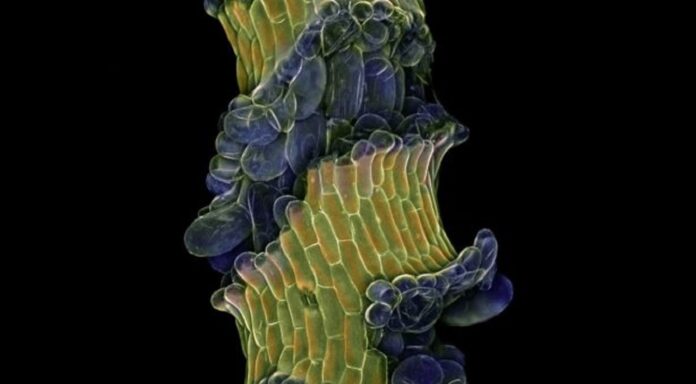The development of multicellular organisms depends on the coordination of cell growth between layers, which is made simpler by mechanical connectivity and molecular signaling. During development, cell layers can slide, fold, and overlap one another to produce the intricate structures found in the living world. Genes modify how different layers interact, but their exact mechanisms remain unclear.
A dwarf mutant of the carnivorous plant Utricularia gibba has been found by researchers at the John Innes Centre. The airspaces in the stems of this floating plant lead the vascular column inside the stem to bend when stressed.
Most plants, which have solid stems, would not exhibit this effect. The researchers saw that the central column of a dwarf mutant was wavy rather than straight, and they hypothesized that an internal struggle between the plant stem and the epidermis or skin created this wobbling spine. Dr. Richard Kennaway’s computational modeling demonstrated that this idea might account for what was observed.
Professor Enrico Coen of the John Innes Centre, an author of the study which appears in Science, said, “We realized that in these types of dwarf, only the epidermis, the skin of the stem, want to be short. The internal tissue still wants to be long hence the buckling effect.”
He added, “This was a surprise previously, people had thought that dwarf varieties, which are very important in agriculture, would be dwarf because everything in the stem is affected to grow less, but it’s just the skin, in this case, creating a sort of straitjacket.”
The Utricularia gibba dwarf mutant lacks a growth hormone called brassinosteroid, which ordinarily causes the skin to flex, providing a more forgiving straitjacket and extending the plant stem.
Coauthor Dr. Christopher Whitewoods at the Sainsbury Laboratory, Cambridge University, emphasizes the potential importance of these findings for future research, saying, “The fact that mechanical interactions between cell layers control growth in the stems of two wildly different species raises the question of whether they control other aspects of plant development, such as the complex internal patterning of leaves. We are excited to test whether this is the case”.
They employed a mutation in the model plant Arabidopsis that weakens the glue between cells to investigate if lowering brassinosteroid caused large fissures in the skin of the stem as a result of the stressors.
Professor Enrico Coen explains, “That is exactly what we saw; normally, an Arabidopsis stem with weakened glue will crack slightly because the hormone is there to loosen the straitjacket. But when the hormone was missing, the skin was completely ripped off, and the plant was almost skinless.”
Coauthor Professor Richard Smith’s computational modeling revealed that the brassinosteroid hormone likely relaxed the straitjacket by loosening filaments in the epidermal cell walls.
The researcher said, “Plant cells are stuck together and are forced to behave in a coordinated way just by their pectin, their glue, that binds them. What we show in this study is that this is an incredibly powerful force; the glue is so strong you only need to change growth in one layer, and the other cells will follow.”
The researchers discovered that the glueyness of plant cells is also an important factor in growth coordination. The glueyness of plant cells is a tremendously powerful force; changing growth in one layer will cause the other cells to follow.
This discovery shed light on dwarfing forms of crops such as wheat and rice, which are at the heart of agriculture’s Green Revolution, explaining how genes control their growth and how we may improve their efficiency in the future.
The study also relates to developmental processes in animals, such as the formation of crocodile skin cracks and the shaping of the intestine, where mechanical interactions between layers are also thought to play a part. The first glimpse of the wobbly tissue in the dwarf aquatic plant was exciting because it gave an idea of what might be going on. The biggest excitement came from testing the idea in a completely different system.
The findings shed light on dwarfing varieties of crops, like wheat and rice, which underpin agriculture’s Green Revolution, explaining how genes control their growth and how we might improve their efficiency in the future.
The finding also applies to animal developmental processes, including the shape of the intestine and the production of crocodile skin fissures, where mechanical interactions between layers are also believed to be important.
He said, “Nature is elusive. Ninety-nine percent of nice ideas fall flat on their face when put to a critical test. But occasionally, an idea survives, and you then know that Nature has revealed one of its secrets to you.”
Dr. Robert Kelly-Bellow, the study’s lead author, believes it was a perfect opportunity to investigate a mutation in a carnivorous plant. He claims that when he caught his first glimpse of the shaky tissue in the dwarf aquatic plant, it sent him down an unexpected turn.
Journal Reference:
- Kelly-Bellow, R., Lee, K., Kennaway, et al. Brassinosteroid coordinates cell layer interactions in plants via cell wall and tissue mechanics. Science. DOI: 10.1126/science.adf0752
